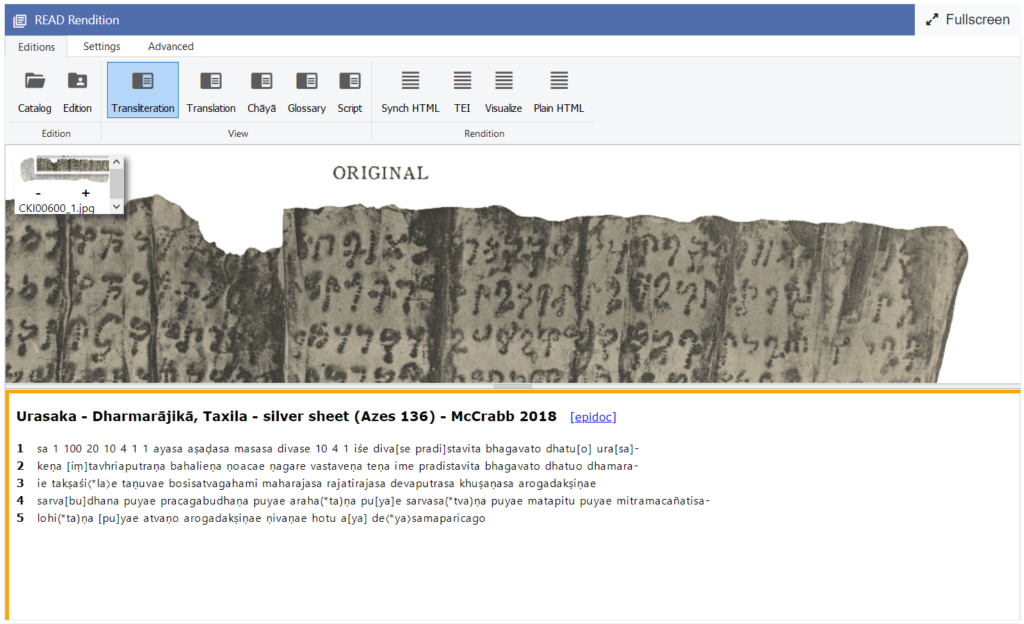This steatite miniature stūpa was discovered in a Pathan village in Swāt where it was being used as a money-box. A Kharoṣṭḥī inscription is engraved around the entire circumference of the upper part of the stūpa base. The text records the establishment of relics of the lord Śākaymuni by the Meriadarch Theodotus for the benefit of many.
Conventional Name Taxila Silver Scroll | Findspot Pakistan, Swāt | Archeological Report: Konow 1929 | Item Steatite Stupa Base | Surface Recto | Dimensions Height: 12.7 Diameter: 12.7 | Date | Collection | Current Location Lahore Museum, Pakistan – G344 | Language/Script Gāndhārī/Kharoṣṭḥī
Content Summary
The Meriadarch Theodotus established relics of the lord Śākaymuni for the benefit of many.
Analysis
Editions
The initial edition by Konow was based on rubbings and an inked tracing whilst a subsequent edition by Salomon was based on a series of photographs. A 3D model of the reliquary has been developed to support the current edition.
McCrabb 2022Keywords
Benefit, Buddha, EraRulerDate, Establishment
Previous Editions
-
Konow, Sten. 1929. Kharoshṭhī Inscriptions with the Exception of Those of Aśoka. Corpus Inscriptionum Indicarum, Vol. II, Part I. Calcutta: Government of India Central Publication Branch. 2–4
-
“Gandharan Reliquary Inscriptions.” In: David Jongeward, Elizabeth Errington, Richard Salomon and Stefan Baums, Gandharan Buddhist Reliquaries. Gandharan Studies, Volume 1. Seattle: Early Buddhist Manuscripts Project. 197-99
Other References
-
Bibliographic details of references to this inscription are available from
(
Gāndhārī Language and Literature
)
Acknowledgements
Development of the 3D model was undertaken by Murtaza Taj (LUMS, Lahore). Research on this edition and production of the digital edition was completed with the generous support of the Prakaś Foundation. The transliteration, translation, chāyā and glossary have been reviewed by Mark Allon and Stephanie Majcher.
Digital publishing by Ian McCrabb
Each digital edition includes background information about the text, a summary of its content, and references to parallel texts and related publications. Users can explore the text, image, and other analysis resources through various preset views from the READ interface, or customize the views themselves.
By developing the text in READ, the text and image are linked such that selecting a syllable, word, or compound in the text or glossary will highlight the associated akṣaras on the manuscript. This allows you to in effect “read” the manuscript as you read the transcribed text, even if you do not know the script.
Users can choose from several preset READ views by selecting the tabs at the top. Each of these convenient arrangements of text and resources is suited to a different experience with the manuscript. For instance, choose the Script view to study the paleography of the manuscript or the Glossary view to study its vocabulary. It is recommended that the user toggles through the default views to gain a holistic perspective of the text.

- Transliteration: Image and transliteration.
- Translation: Transliteration and translation.
- Chāyā: Transliteration and chāyā.
- Glossary: Image, transliteration, and glossary.
- Script: Image, transliteration, and script chart
- Visualize: Visualize the text structure display.
- Synch HTML: Interactive synchronized rendition.
- TEI: EpiDoc TEI rendition.
- Plain HTML: Transliteration in HTML format.
Avś
Be
Ce
Ch.
CPS
DhG
Ee
FJJ
Mahīś
MūSā
Mvu
P
SĀ
SBhV
Se
Skt.
SN
T
Tib.
Vin
Avadānaśataka (ed. Speyer 1906–1909)
Burmese (Chaṭṭhasaṅgāyana) edition
Sri Lankan (Buddha Jayanti Tipiṭaka Series) edition
Chinese
Catuṣpariṣat-sūtra (ed. Waldschmidt 1952–1962)
Dharmaguptaka
European (Pali Text Society) edition
Fobenxing ji jing (T 190)
Mahīśāsaka
Mūlasarvāstivāda
Mahāvastu-avadāna (ed. Senart 1882–1897)
Pali
Saṃyukta-āgama (T 99)
Saṅghabhedavastu (ed. Gnoli 1977–1978)
Thai (King of Siam) edition
Sanskrit
Saṃyutta-nikāya
Taishō 大正 edition
Tibetan
Vinaya

